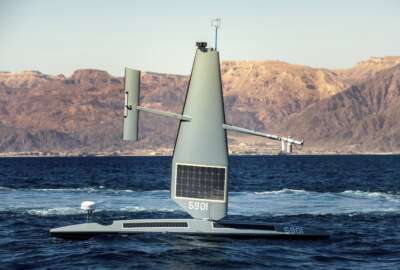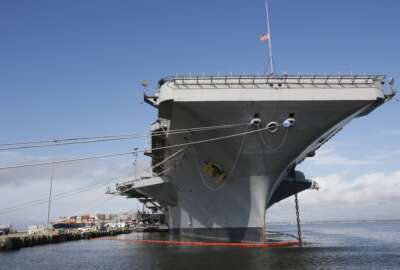
The Navy has bold ideas for a new museum
Five architectural firms are now at work on proposals for a brand new museum for the Navy. To learn more about why the Navy will build a new museum, as well as ...
Five architectural firms are now at work on proposals for a brand new museum for the Navy. To learn more about why the Navy will build a new museum, as well as to hear about the Navy’s vision for the new facility, Federal Drive with Tom Temin talked with retired Rear Admiral Samuel Cox, the director of the Naval History and Heritage Command.
Interview transcript:
Tom Temin And let’s begin at the beginning. Why a new museum for the Navy?
Samuel Cox Well, two primary reasons. One, we already have a fantastic museum, but it’s in a building that was never intended to be one. It’s all gun factory. So the environment is not good for the artifacts. The primary reason, though, is because of the security on the Navy Yard, it’s very difficult for the American people to get in. So we’re not meeting our mission of telling the story of the U.S. Navy to the American public.
Tom Temin I’ve been to the Navy Yard. It’s easy to get out, but pretty hard to get in down there near the ballpark in Washington, D.C., so where will the new facility be located?
Samuel Cox The new museum will be right outside the Navy Yard, about a six minute walk from the Navy Yard metro stop.
Tom Temin All right. And as you face the Navy Yard, to the left or the right?
Samuel Cox If you’re looking south from M Street will be to the right.
Tom Temin Ok.
Samuel Cox So if you’re looking towards Anacostia River.
Tom Temin Yeah. And so you’re going to an area that is already pretty heavily trafficked relative to years ago down at that part of D.C.
Samuel Cox That’s correct. It’s one of the hottest neighborhoods in D.C., and that’s one reason why multiple studies identified that spot as being the best spot in the entire United States for this museum. Part of it is because of the traffic that will get, and that adds to the mission of what we’re trying to accomplish.
Tom Temin Sure. And at lunchtime, the staff can walk over to the salt line and have a Narragansett.
Samuel Cox Absolutely. And the civilians, the people can come into our cafe and gift shop and help defray the cost of operating the museum.
Tom Temin And you narrowed 37 possible firms down to five that are in competition for the design of this building. One of them, I noticed, was Frank Gehry and associates. He’s known for really avant garde, off the wall, so to speak, types of buildings. So fair to say the Navy is going bold on this one?
Samuel Cox Well, we hope at some point the artist is going to collide with the engineer, and the building will have to be built to Navy force protection standards, because safety of the public in there will be our number one priority. But this was called an artistic ideas competition. It’s not the actual final design competition, that’ll come in later after the foundation raises money to do it. So it could be one of these five firms, or it could be someone else who actually gets the contract, if you will, to build it. We were pleased, these were high end, global, incredibly accomplished firms that expressed an interest in doing this, which was quite gratifying.
Tom Temin Yeah. Federal projects are actually attractive to architectural firms, because over the years the federal government has done some leading architecture, believe it or not, the general public doesn’t realize that. And just a question on the financing. What is the estimated cost of this? And is there any appropriated funds? Or is it all private fundraising?
Samuel Cox The estimated cost over the course of the museum, which will be built in phases, so not all at once, but a high end museum in Washington, D.C. area is going to cost 400 million and upwards. This will not be taxpayer dollars that build the museum. This will be raised by a foundation that’s set up specifically to do that. Now, after it’s built, the Navy will staff and operate the museum, like I do now with the current museums, and the Navy will maintain the museum. But the foundation will also continue to raise money via the gift shop, parking, things like that. So they’ll be able to continue to defray the operating costs of the museum.
Tom Temin We’re speaking with retired Rear Admiral Samuel Cox. He’s director of the Naval History and Heritage Command. And just briefly, you are a retired officer, of course, and now you are a senior executive service employee. Correct?
Samuel Cox That’s correct.
Tom Temin At the Heritage Command, Give us the quick overview of the History and Heritage Command.
Samuel Cox Well, within the United States Navy, we took everything that was history related and combined it into one actual command. It’s a Navy command, and having a civilian like me in charge of a Navy command is pretty unique. But we’re responsible for the Navy’s official history programs, the operational archives library, the Navy’s collection of art photographs, rare books, weapons, 1100 display aircraft that are around the country. And kind of unique, is the federal executive agent for the Sunken Military Craft Act. So, I’m responsible for 3,000 U.S. Navy shipwrecks and 14,000 aircraft wrecks that we try to keep from being unauthorized, pilfered.
Tom Temin Right. They are sacred sites for the nation.
Samuel Cox Exactly.
Tom Temin And with respect to what you mentioned as some of the artifacts, clearly everything the Navy has in its stores will not fit in any museum. So what will be the selection criteria? And what are some of the unique requirements for a naval museum, versus, say, where you would hang the Mona Lisa?
Samuel Cox Well, we still have much of the same issues that any other museum would have. You need a very high tolerance for environment, humidity, temperature, things like that in order to preserve artifacts over the long term. We also have a process where we rotate artifacts. Some will last forever or practically. Others are very fragile, and if you keep them on display too long you’ll actually severely degrade the artifacts. So there’s a science that goes into how to do this. Certainly, the selection criteria for artifacts, I have about 500,000 within our main collection, and we have ten other museums, most fairly small affairs. But we have quite a few artifacts to choose from, and we’ll be looking for those that tell the most profound story about the history of the United States Navy. Try to find those that have a personal connection, because people connect to other people. And rather than just having, hey, here’s a thing. Here’s a story that goes with it and the person that goes with it that is compelling.
Tom Temin And some of these artifacts are quite large. I think I read in one of the releases the top part of a submarine, the part that sticks up.
Samuel Cox That’s great. The sail, and that’s the part that sticks up above the water. And it’s the sale of the USS Honolulu, which happened to be the command for two officers who became chief of naval operations, and another Cecil Haney, African-American, four star. So it was very successful at producing admirals coming out of that particular boat.
Tom Temin All right. So a lot of people might want to climb in there while they were going through. And do you sense that as a smaller percentage of the population actually will have served in the military in some ironic way that increases the interest in these types of museums?
Samuel Cox I think there’s kind of a cyclical thing going on here, kind of a renewed interest. For example, in World War Two, where the grandchildren of those who served in that war asked their parents, what would grandpa do? And they don’t know, because that generation tended not to talk. And now they’re going to museums, they’re reading our books and whatnot, and learning about what happened before.
Tom Temin Any other interesting artifacts that we can look forward to, by the way, that will be definitely in there?
Samuel Cox It’s hard for me to choose. There’ll be many. We’ll have a dauntless dive bomber, and you wonder, well, why an airplane? Well, you command the sea by commanding the air over the sea. And the dauntless was the aircraft that turned the tide of World War II at the Battle of Midway. At great cost, these were aviators at a time when the nation was not ready for war and they paid with their lives in order to stop the Japanese advance. But they did. So there’s incredible story about valor and also preparedness, like don’t be caught like that again, that goes with that particular artifact.
Tom Temin And what are our timelines here? When would you like to see the doors open?
Samuel Cox We would like to do a groundbreaking ceremony for the U.S. Navy’s 250th birthday in 2025. That’ll be dependent on how fast the foundation can raise the money. It’s a heavy lift, that’s an aspirational goal. We’ll see if we make it.
Tom Temin And by the way, any Marine Corps exhibits in there? Because they have their own facility looming over Route 95.
Samuel Cox They have their own. However, the entire history of the U.S. Navy and the Marine Corps has been very closely interwoven. So we have the fighting top of the USS Constitution, which was a frigate during the war of 1812, and it was Marines on that fighting top with a rifle shooting down at the other ship. And then throughout World War II, many of our operations were amphibious in nature. So it’ll be focused on the Navy putting the Marines ashore, as opposed to what the Marines did ashore. But there’s a close relationship there.
Copyright © 2024 Federal News Network. All rights reserved. This website is not intended for users located within the European Economic Area.
Tom Temin is host of the Federal Drive and has been providing insight on federal technology and management issues for more than 30 years.
Follow @tteminWFED





